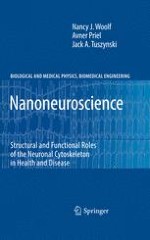2010 | Buch
Nanoneuroscience
Structural and Functional Roles of the Neuronal Cytoskeleton in Health and Disease
verfasst von: Nancy J. Woolf, Avner Priel, Jack A. Tuszynski
Verlag: Springer Berlin Heidelberg
Buchreihe : Biological and Medical Physics, Biomedical Engineering
